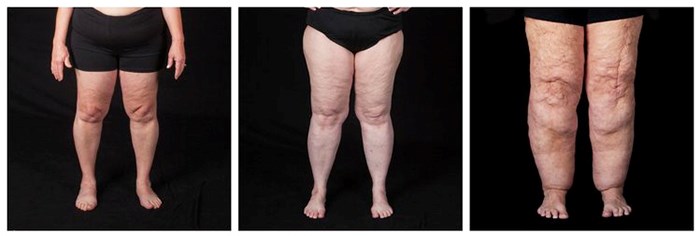When Connie Young’s mother and aunt went to a Cardiologist appointment in Mesa Arizona in 2015, he made an offhand comment about something genetic going on with their legs.Ìý After hearing about the doctor’s comment, Connie began searching the internet using the key words ‘big legs, genetic’ and found answers to something that had weighed heavily on her for many years – both physically and mentally. Finally, there was a glimmer of enlightenment regarding her own health issues.
ÌýÌýÌýÌýÌýÌýÌýÌý Young had been to the doctor many times throughout her life and many of them believed that she was unable to lose the weight on her legs because she wasn’t trying hard enough. One went so far as to recommend bariatric surgery. It was very freeing to finally have a diagnosis of lipedema, a chronic medical condition that affects approximately 11% of women. It is characterized by a symmetric buildup of adipose tissue (fat) in the legs and arms. A common but under recognized disorder, lipedema may cause pain, swelling and easy bruising. It may be accompanied by an unusual texture within the fat that can feel like rice, peas or walnuts beneath the surface of the skin. Lipedema is not rare, but a proper diagnosis is rarely made. Few physicians are comfortable diagnosing and treating lipedema because of the lack of diagnostic tests and research-backed treatments. Alongside the physical pain symptoms, it can impact mental health and quality of life, leading to lack of energy, low self-esteem, feelings of hopelessness or even eating disorders. Lipedema was first reported in literature at the Mayo Clinic in 1940, and knowledge in the area of lipedema spread across Europe, especially in Germany and Austria, and is slowly advancing in the US and Canada.Ìý Lipedema fat does not reduce through either diet or exercise but can managed once a person knows what it is.Ìý
ÌýÌýÌýÌýÌýÌýÌýÌý Lipedema is often confused with Lymphedema, which results from a failure to pump lymph fluid out of the limb or damaged lymphatic vessels that leak an abundance of lymph fluid resulting in pooling in the hand or foot, eventually spreading up the arm or leg. Advanced stages of Lipedema can, however, cause lymphedema as well. This is known as Lipo-lymphedema.
ÌýÌýÌýÌýÌýÌýÌýÌý Young’s investigation led her to Dr. David Amron, in California, where she had Lymph sparing surgery, the removal of the abnormal fat cells between the skin and muscle. She had 2 separate surgeries, which are not covered by Canadian healthcare benefits. After the surgery, Young had manual lymph drainage therapy with a specialized therapist daily and once back in Canada drove to Weyburn a couple times a week for a few months for the therapy.Ìý She also had her legs wrapped with foam and bandages for three months and then compression daily for a few months.Ìý She now manages the inflammation by following a ketogenic way of eating and does not have to wear compression all the time.
ÌýÌýÌýÌýÌýÌýÌýÌý Dianne Wilson was diagnosed with Lipedema 35 years ago by a Â鶹ÊÓƵ African doctor who recognized the disorder but didn’t know where to send her for treatment. She would go to her doctor and tell him all of her pain and symptoms but until she saw Connie’s story, she didn’t know treatment was available.Ìý Last October Dianne had Lymphoscintigraphy – a nuclear test that shows how much lymphedema the patient has.Ìý
ÌýÌýÌýÌýÌýÌýÌýÌý Since there is so little information available, Young and Wilson are excited to be a part of the new Saskatchewan Lipedema Association, formed in April of this year. They are also wanting to start a support group in this area so that people have someone to share their experiences and feelings with.Ìý
ÌýÌýÌýÌýÌýÌýÌýÌý A Telehealth seminar for Lipedema Awareness has been confirmed for the evening of June 20 and will be available in many locations throughout Saskatchewan.Ìý For further information please call Connie Young at 306.577.8968 or Dianne Wilson at 306.453.2593.
Ìý




